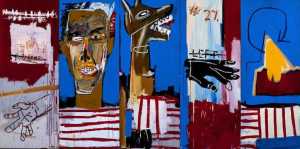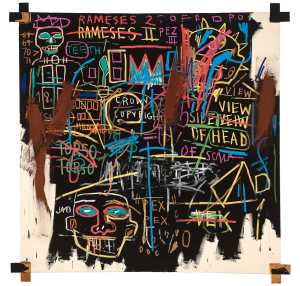The French Dadaist Marcel Duchamp made the first version of this case on 1 January 1941. Some 300 of them were finally produced. The case contains Duchamp's complete oeuvre reproduced in the form of 69 carefully constructed miniature replicas and black and white reproductions coloured in by hand. The contents of the case includes the famous urinoir and the masterpiece 'La Mariée mise à nu par ses célibataires, même'. In this way, Duchamp created a portable museum, in which his work as a whole is exhibited.
The works are reproductions of earlier works, but are, at the same time, unique handmade pieces. Together they form a museum, which is presented in its entirety as a new work of art. Duchamp did this with an irony typical of him: the case is most like that of a travelling salesman.

Specifications
| Title | De ou par Marcel Duchamp ou Rrose Sélavy (La boîte-en-valise) |
|---|---|
| Material and technique | Leather, wood, cardboard, glass, leatherette, plaster, gouache on mica, offset on paper, gelatine silver print on fibre-based paper |
| Object type |
Assemblage
> Three-dimensional object
> Art object
|
| Location | This object is in storage |
| Dimensions |
Height 41 cm Length 38 cm Width 10,5 cm |
|---|---|
| Artists |
Artist:
Marcel Duchamp
|
| Accession number | MB 1990/3 (MK) |
| Credits | Purchase Stichting Fonds Willem van Rede. On permanent loan from the Cultural Heritage Agency of the Netherlands, 1990 |
| Department | Modern Art |
| Acquisition date | 1990 |
| Creation date | in 1952 |
| Collector | Collector / W. van Rede |
| Provenance | The Pinacotheca Gallery (Rose Fried), New York 1952; Lydia & Harry Lewis Winston, New York 1952-90; Sotheby’s New York, 16 May 1990, lot 57 |
| Exhibitions | New York 1953-54; Rotterdam 1998a; Bruges 1999; Rotterdam 2013-14b; Rotterdam 2017a |
| Internal exhibitions |
Marcel Duchamp, Kunstenaar - Knutselaar (2013) Gek van surrealisme (2017) |
| External exhibitions |
Dal nulla al sogno (2018) Surrealist Art - Masterpieces from Museum Boijmans Van Beuningen (2021) A Surreal Shock – Masterpieces from Museum Boijmans Van Beuningen (2021) Only the Marvelous is Beautiful (2022) A Surreal Shock. Masterpieces from Museum Boijmans Van Beuningen (2023) Dalí, Magritte, Man Ray and Surrealism. Highlights from Museum Boijmans Van Beuningen (2023) |
| Research |
Show research Digitising Contemporary Art Show research A dream collection - Surrealism in Museum Boijmans Van Beuningen |
| Literature | New York/Philadelphia 1973, p. 304, cat. no. 158; Bonk 1989, pp. 197-98; Castleman 1994, p. 232, fig. 193; De Jonge 1995, p. 50; New York 1999, pp. 124-46, fig. 208; Schwarz 2000, pp. 762-64, cat. no. 484; Von Berswordt-Wallrabe 2003, pp. 128-35; Rotterdam 2017, p. 334 |
| Material | |
| Object | |
| Technique |
Gelatine silver print
> Bromide print
> Photographic printing technique
> Mechanical
> Planographic printing
> Printing technique
> Technique
> Material and technique
Offset print
> Mechanical
> Planographic printing
> Printing technique
> Technique
> Material and technique
Gouache
> Drawing technique
> Technique
> Material and technique
|
| Geographical origin | France > Western Europe > Europe |
Do you have corrections or additional information about this work? Please, send us a message
Entry catalogue Digitising Contemporary Art, A dream collection - Surrealism in Museum Boijmans Van Beuningen
Author: Bert Jansen
La boîte-en-valise is a kind of personal oeuvre catalogue, made as a portable miniature museum. It contains sixty-eight of Marcel Duchamp’s most important artworks in the form of photographic reproductions and some miniature replicas. He began to make it in Paris in 1935 after the publication of the notes for Le Grand Verre in La boîte verte. By that time a large part of his oeuvre was already in one American private collection, that of Walter and Louise Arensberg, and so not accessible to the public. He used La boîte-en-valise to make his oeuvre public and show it as a coherent entity. The valise is essentially an expandable box which can be transformed into a three-dimensional scale model to mimic the walls of an exhibition gallery. For the most part the material came from earlier publications, of which Duchamp had had extra copies made.
The artist put together the first three valises in Paris in the spring of 1941. During the Nazi occupation he secretly moved the material to Vichy, after which it was shipped to New York by way of Portugal. At the end of 1942, Duchamp himself returned to New York, where he continued to assemble the material. The first twenty versions of La boîte-en-valise were reserved for friends and a few museums and contained an original artwork that he considered appropriate for the recipient. The valises were produced in different stages.[1] The last series appeared in 1971, three years after the artist’s death. As planned, three hundred copies were made. Arturo Schwarz, who worked on an oeuvre catalogue in collaboration with the artist, identified seven series, from A to G. The example owned by Museum Boijmans Van Beuningen, from the B series, is one of the fifteen copies the New York gallery owner Rose Fried sold between 1952 and 1954.
With the acquisition of La boîte verte and La boîte-en-valise in 1990 the museum obtained two key works in the artist’s oeuvre. Both give an idea of the way Duchamp put the concept of uniqueness and reproducibility into perspective. They also make clear that an essential aspect of Duchamp’s oeuvre lay in the relationship between the individual works – a relationship which, in the case of La boîte-en-valise, was expressed in his decision to make a miniature museum he put together himself. The fact that ideas about uniqueness and multiples in post-1960 art have changed is to a significant extent attributable to Duchamp. He had a huge influence on the development of the post-modern concept of art and his influence still makes itself felt in contemporary art. Duchamp’s position in Dada and Surrealism and his impact on generations of artists that came after him is why Museum Boijmans Van Beuningen has been collecting his work since 1989.[2]
All about the artist
Marcel Duchamp
Blainville-Crevon 1887 - Neuilly-sur-Seine 1968
Marcel Duchamp can be considered one of the founders of Dadaism and conceptual art. He became famous for, among other things, his 'ready mades': existing...
Bekijk het volledige profiel























